A Hybrid Blockchain Solution for Electric Vehicle Energy Trading: Balancing Proof of Work and Proof of Stake
Abstract
1. Introduction
1.1. Background and Motivation
1.2. Literature Review
1.3. Objectives and Structure
2. Methodology
2.1. Selection of Blockchain Technology
- Security: This includes data integrity, ensuring transactions cannot be altered, and confidentiality through encryption to protect user privacy. It also involves resistance to attacks, such as Sybil and 51% attacks [43], and ensuring that consensus mechanisms are secure.
- Scalability: Scalability measures the blockchain’s ability to accommodate an increasing number of participants (i.e., EVs) and transactions (i.e., charging process). Specifically, this includes the speed at which consensus is achieved among nodes, the rate at which new transactions are added to blocks, and the overall transactions per second the system can handle.
- Sustainability refers to the long-term viability of the blockchain system, ensuring it can maintain performance and security while minimizing environmental and resource impacts. This involves optimizing energy consumption, energy efficiency, supporting scalable growth, and using eco-friendly consensus mechanisms for carbon footprint reduction.
2.2. Blockchain System Architecture:
- Decentralized network: A blockchain-based network where EVs, charging stations, and other participants (e.g., validators) are distributed across different locations.
- Smart contracts: These automate the energy trading process, including dynamic pricing, transactions, and incentives.
- Consensus mechanisms: The blockchain employs either PoW or PoS to validate transactions and secure the integrity of the energy trading process.
2.2.1. Stakeholder Setup
2.2.2. Blockchain Integration
2.2.3. Proof of Work Mining
2.2.4. Proof of Stake Validator Selection
2.3. Smart Contract
2.3.1. EVs Requesting Energy
- ▪
- is the maximum capacity of the EV’s battery (kWh);
- ▪
- is the energy requested by the EV (kWh);
- ▪
- is the actual charge the EV battery (kWh).
- ▪
- is the total cost of energy traded between the EV owner and the grid (GBP);
- ▪
- is the energy price (GBP/kWh).
2.3.2. Energy Pricing
Time-of-Use Pricing (ToU)
- ▪
- represents the energy price at time t (GBP/kWh);
- ▪
- is the energy price during peak (daytime) period (GBP/kWh);
- ▪
- is the energy price during off-peak (nighttime) period (GBP/kWh).
Real-Time Pricing (RTP)
- ▪
- represents the actual energy price at time t (GBP/kWh), (Equation (3));
- ▪
- is the real-time price at time t for the EV (GBP/kWh);
- ▪
- is a coefficient that scales the price based on demand;
- ▪
- is the power grid load at time t (kWh).
Incentives for Optimal Charging Behavior
- ▪
- is the incentive provided to the EV owner for off-peak charging period (GBP);
- ▪
- is the incentive factor;
- ▪
- is the charging time (s).
3. Results and Discussion
| Algorithm 1: The proposed system simulation algorithm |
1. Initialization:
|
3.1. Result Verification Compared to Previous Studies
- ▪
- Scalability: The hybrid model achieves 560 TPS, which is a significant improvement over PoW’s 7 TPS. It provides much better throughput than PoW, making it suitable for real-world applications that require higher transaction volumes.
- ▪
- Energy efficiency: While the hybrid model’s energy consumption (0.8987 kWh/Tx) is higher than PoS (0.002 kWh/Tx), it is dramatically lower than PoW (707.6 kWh/Tx). This represents a substantial reduction in energy use compared to PoW while retaining the benefits of the PoW consensus mechanism, such as increased security.
- ▪
- Reduced environmental impact: CO2 emissions for the hybrid model are 0.7974 g per transaction, much lower than the 3.8 × 105 g per transaction from PoW. While PoS is still more eco-friendly, the hybrid solution significantly reduces environmental harm compared to PoW, making it a more sustainable choice.
- Significantly better scalability than pure PoW.
- Reduced energy consumption compared to PoW, while still maintaining a strong security protocol.
- Lower CO2 emissions, contributing to a more eco-friendly solution.
3.2. PoW Mining Time
3.3. Transaction Costs per EV
3.4. Energy Consumption per EV
3.5. Proof of Stake (PoS) Validator Participation
3.6. Time-of-Use Pricing Model
3.7. Incentive-Based Pricing
3.8. Energy Distribution Among EVs
3.9. Grid Load Before and After Smart Contract Implementation
4. Opportunities, Challenges, and Future Directions
4.1. Opportunities
- Decentralized Energy SystemsThe decentralization of energy production and consumption is one of the most transformative aspects of blockchain for energy systems. As smart grids and decentralized energy solutions gain traction globally, blockchain can provide a secure, transparent, and immutable framework for managing these systems. Energy transactions can occur directly between users (peer-to-peer), reducing reliance on central utilities and traditional intermediaries. This decentralized approach not only improves security, but also helps to foster community-based energy networks, where local communities or regions can efficiently produce, consume, and trade energy without needing a central authority to manage the flow.
- Dynamic Pricing and EfficiencyReal-time pricing is a game changer for energy management. The blockchain-based solution facilitates dynamic pricing, ensuring that energy prices fluctuate according to demand, grid conditions, and renewable energy availability. With the widespread adoption of EVs, dynamic pricing can incentivize owners to charge their vehicles during off-peak times, or when renewable energy generation (such as solar or wind) is abundant, reducing the strain on the grid and lowering overall costs. This real-time optimization leads to more efficient energy consumption patterns, which ultimately contribute to a more sustainable and cost-effective energy ecosystem.
- Incentivizing Stakeholder ParticipationBy integrating the hybrid PoW–PoS model, blockchain introduces an incentive structure that rewards stakeholders for their participation in energy trading. The PoS model ensures that those who stake energy (whether EV owners, charging stations, or other energy producers) can benefit from both transactional rewards and long-term gains. This incentive framework encourages more active engagement in decentralized energy systems, particularly in areas where energy markets are fragmented or where traditional utility companies have limited access. Stakeholders are motivated to participate, not just to meet energy needs, but also to reap the benefits of a decentralized energy market.
- Integration with Smart CitiesAs cities become “smarter”, the integration of blockchain-based EV charging systems can complement existing smart city initiatives. In smart cities, vehicles, homes, and infrastructure are interconnected through the Internet of Things (IoT), allowing for them to dynamically exchange energy and information. Blockchain technology ensures that these exchanges are secure, transparent, and immutable. The integration of EV charging stations with this ecosystem allows for the seamless management of energy flows within the city, enabling real-time coordination between vehicles, charging stations, energy grids, and other stakeholders. This would not only improve the efficiency of energy use, but also contribute to the development of more sustainable urban transportation systems, ultimately helping cities reduce their carbon footprint.
- Support for Renewable EnergyOne of the most promising aspects of blockchain technology in the energy sector is its ability to support the adoption and integration of renewable energy sources. With blockchain, the transparency and immutability of energy transactions make it easier for clean energy producers to sell their surplus energy directly to consumers, including EV owners. This facilitates the creation of a decentralized green energy marketplace, where renewable energy producers (such as solar or wind farms) can directly engage with consumers. Moreover, blockchain can provide consumers with assurances that the energy they are consuming is indeed green, as each transaction can be verified on the blockchain. As the world transitions toward renewable energy, blockchain could play a critical role in supporting these transitions by creating more efficient, transparent, and sustainable energy trading systems.
4.2. Challenges
- Scalability IssuesAs the number of EVs and energy transactions grows, blockchain systems may face scalability issues, particularly when using PoW mechanisms. PoW requires significant computational power to validate transactions and add them to the blockchain, which can result in slower processing times and higher costs as the network expands. As EVs become more widespread and energy trading grows, the blockchain network may struggle to keep up with the increased demand. Exploring lighter, more scalable consensus mechanisms, such as PoS or hybrid PoW–PoS models, will be critical for ensuring that the blockchain system can handle the volume of transactions while maintaining decentralization and security.
- Energy Consumption of BlockchainThe PoW consensus algorithm, which is heavily reliant on mining, consumes a significant amount of energy. This is particularly concerning in the context of an energy trading system for EVs, as the benefits of adopting electric vehicles to reduce carbon emissions could be undermined by the environmental impact of blockchain mining. To mitigate this, there is a need to explore more energy-efficient consensus algorithms, such as PoS or Proof-of-Authority (PoA), that require far less energy to maintain the integrity of the blockchain. Transitioning to these mechanisms will not only make blockchain more sustainable, but also align with the goals of reducing global energy consumption and greenhouse gas emissions.
- Integration with Existing InfrastructureThe integration of blockchain-based solutions into existing energy grids and charging stations presents a major challenge. Traditional charging stations and grid management systems were not designed to support decentralized energy trading. Upgrading existing infrastructure to support blockchain-based solutions requires significant investment and collaboration between blockchain developers, energy providers, and regulatory authorities. Furthermore, interoperability between different charging stations, energy grids, and blockchain platforms needs to be established to ensure seamless communication and transaction processing.
- Regulatory and Legal ChallengesEnergy trading is a highly regulated sector, and blockchain-based solutions must adhere to existing legal and regulatory frameworks. Decentralized energy trading challenges traditional market structures, and governments may be hesitant to embrace blockchain technology due to concerns about market stability, consumer protection, and regulatory compliance. Developing appropriate regulations that allow for decentralized energy trading while ensuring the protection of consumers and the stability of the energy grid will be crucial for widespread adoption. Furthermore, legal uncertainties surrounding the ownership and transfer of energy assets could hinder the development of a global blockchain-based energy market.
- Market Acceptance and TrustDespite the potential benefits, there remains a level of skepticism and mistrust surrounding blockchain technology. Consumers, energy providers, and regulators may be wary of adopting blockchain-based energy trading solutions due to concerns about security, reliability, and long-term sustainability. Public education campaigns that demonstrate the technology’s capabilities, security features, and potential economic advantages will be essential in building trust and encouraging the large-scale adoption of blockchain systems for energy trading.
- Data Privacy and SecurityWhile blockchain provides enhanced transparency and security, it also raises concerns about data privacy. The detailed records of energy usage and transaction data stored on the blockchain could reveal sensitive information about consumer behavior, energy consumption patterns, and private transactions. This information could be vulnerable to misuse if not properly managed. To address these concerns, privacy-enhancing technologies such as zero-knowledge proofs (ZKPs) or advanced cryptographic techniques will be crucial. These technologies allow for the secure verification of transactions without revealing sensitive details, thus maintaining user privacy while still benefiting from the blockchain’s transparency.
4.3. Future Directions
- Enhanced Consensus AlgorithmsFuture research should focus on developing consensus algorithms that are specifically designed for the energy sector. These algorithms must be scalable, energy-efficient, and able to support high volumes of transactions without compromising security or decentralization. Hybrid consensus models, combining PoW and PoS or PoA, may be particularly well-suited to address the scalability and energy consumption issues of PoW alone.
- Blockchain InteroperabilityThe ability of different blockchain networks to communicate and collaborate is essential for large-scale adoption. Researchers should focus on developing standards and protocols that allow for interoperability between different blockchain platforms, facilitating cross-border and cross-platform energy transactions. This will allow for energy trading to become more fluid and efficient, creating a global decentralized energy market.
- Decentralized Energy MarketsFuture advancements could lead to the creation of fully decentralized energy markets where energy can be traded in real-time among EV owners, charging stations, renewable energy producers, and even consumers. Smart contracts could automatically execute energy transactions based on real-time market conditions, eliminating the need for intermediaries and reducing transaction costs. Decentralized markets would empower individuals and communities to become more self-sufficient, fostering a more resilient energy ecosystem.
- AI and Blockchain IntegrationThe combination of AI and blockchain could provide powerful synergies in optimizing energy trading decisions. AI can forecast energy demand, supply, and market fluctuations, enabling more informed decision-making for EV charging and energy trading. Machine learning algorithms can also optimize energy pricing in real-time, considering factors such as renewable energy availability, grid congestion, and consumer behavior. Integrating AI with blockchain ensures that energy trading remains adaptive and responsive to changing conditions.
- Cross-Sector CollaborationTo overcome the technological, regulatory, and infrastructural challenges, there must be close collaboration between multiple sectors, including blockchain developers, energy providers, policymakers, and EV manufacturers. By aligning the goals of these various stakeholders, we can build a more cohesive framework for decentralized energy trading. Public–private partnerships will play a crucial role in ensuring that the infrastructure, regulatory landscape, and business models are compatible with blockchain adoption.
- Blockchain for Microgrids and Peer-to-Peer Energy TradingMicrogrids represent a promising area for blockchain-based energy trading. Blockchain can facilitate peer-to-peer (P2P) energy trading at the microgrid level, allowing for local communities to directly trade energy and reduce reliance on centralized utilities. This is particularly beneficial for rural and remote areas, where traditional grid infrastructure may be expensive or unreliable. The ability for local communities to trade energy directly could lead to more resilient, self-sufficient, and sustainable energy systems.
- Blockchain-Enabled Green Certificates and Carbon CreditsBlockchain can be used to track and verify renewable energy production through green certificates and carbon credits. EV owners could earn incentives for using clean energy for charging, and these incentives could be transparently recorded on the blockchain. This would create a more efficient and trustworthy system for verifying and trading carbon credits, promoting the wider adoption of renewable energy sources.
5. Conclusions
Funding
Data Availability Statement
Conflicts of Interest
References
- Khan, S.; Amin, U.; Abu-Siada, A. P2P Energy Trading of EVs Using Blockchain Technology in Centralized and Decentralized Networks: A Review. Energies 2024, 17, 2135. [Google Scholar] [CrossRef]
- Xu, Y.; Alderete Peralta, A.; Balta-Ozkan, N. Vehicle-to-Vehicle Energy Trading Framework: A Systematic Literature Review. Sustainability 2024, 16, 5020. [Google Scholar] [CrossRef]
- Amamra, S.-A.; Marco, J. Vehicle-to-Grid Aggregator to Support Power Grid and Reduce Electric Vehicle Charging Cost. IEEE Access 2019, 7, 178528–178538. [Google Scholar] [CrossRef]
- Park, S.; Yun, S.-P.; Lee, K.; Kang, B.; Choi, M.-i.; Jang, H.; Park, S. Design and Implementation of a Futuristic EV Energy Trading System (FEETS) Connected with Buildings, PV, and ESS for a Carbon-Neutral Society. Buildings 2023, 13, 829. [Google Scholar] [CrossRef]
- Ahlqvist, V.; Holmberg, P.; Tangerås, T. A survey comparing centralized and decentralized electricity markets. Energy Strategy Rev. 2022, 40, 100812. [Google Scholar] [CrossRef]
- Ohanu, C.P.; Rufai, S.A.; Oluchi, U.C. A comprehensive review of recent developments in smart grid through renewable energy resources integration. Heliyon 2024, 10, e25705. [Google Scholar] [CrossRef]
- Bandeiras, F.; Gomes, Á.; Gomes, M.; Coelho, P. Exploring Energy Trading Markets in Smart Grid and Microgrid Systems and Their Implications for Sustainability in Smart Cities. Energies 2023, 16, 801. [Google Scholar] [CrossRef]
- IEA. Global EV Outlook 2023; IEA: Paris, France, 2023; Available online: https://www.iea.org/reports/global-ev-outlook-2023 (accessed on 15 February 2025).
- Muhsen, H.; Allahham, A.; Al-Halhouli, A.; Al-Mahmodi, M.; Alkhraibat, A.; Hamdan, M. Business Model of Peer-to-Peer Energy Trading: A Review of Literature. Sustainability 2022, 14, 1616. [Google Scholar] [CrossRef]
- Fuchs, I.; Rajasekharan, J.; Cali, Ü. Decentralization, decarbonization and digitalization in swarm electrification. Energy Sustain. Dev. 2024, 81, 101489. [Google Scholar] [CrossRef]
- Aoudia, M.; Alaraj, M.B.M.; Abu Waraga, O.; Mokhamed, T.; Abu Talib, M.; Bettayeb, M.; Nasir, Q.; Ch, G. Toward better blockchain-enabled energy trading between electric vehicles and smart grids in Internet of Things environments: A survey. Front. Energy Res. 2024, 12, 1393084. [Google Scholar] [CrossRef]
- AM, A.S.; Seçkiner, S.; Eid, B.; Abumeteir, H. Integration of blockchain with artificial intelligence technologies in the energy sector: A systematic review. Front. Energy Res 2024, 12, 1377950. [Google Scholar] [CrossRef]
- Habib, G.; Sharma, S.; Ibrahim, S.; Ahmad, I.; Qureshi, S.; Ishfaq, M. Blockchain Technology: Benefits, Challenges, Applications, and Integration of Blockchain Technology with Cloud Computing. Future Internet 2022, 14, 341. [Google Scholar] [CrossRef]
- Al-Shehari, T.; Kadrie, M.; Alfakih, T.; Alsalman, H.; Kuntavai, T.; Vidhya, R.G.; Dhanamjayulu, C.; Shukla, S.; Khan, B. Blockchain with secure data transactions and energy trading model over the internet of electric vehicles. Sci. Rep. 2024, 14, 19208. [Google Scholar] [CrossRef]
- Khan, K.; Hassan, F.; Koo, J.; Mohammed, M.A.; Hasan, Y.; Sheela, S.; Muhammad, D.; Chowdhry, B.S.; Qureshi, N.M.F. Blockchain-based applications and energy effective electric vehicle charging – A systematic literature review, challenges, comparative analysis and opportunities. Comput. Electr. Eng. 2023, 112, 108959. [Google Scholar] [CrossRef]
- Khan, P.W.; Byun, Y.-C. Blockchain-Based Peer-to-Peer Energy Trading and Charging Payment System for Electric Vehicles. Sustainability 2021, 13, 7962. [Google Scholar] [CrossRef]
- Haitao, L.; Zhipeng, L.; Zhenhao, S.; Shan, Z.; Wenlong, L.; Mu, F. Application of Blockchain Technology in Electric Vehicle Charging Piles Based on Electricity Internet of Things. Wirel. Commun. Mob. Comput. 2022, 10, 8533219. [Google Scholar] [CrossRef]
- Qazi, S.; Khawaja, B.A.; Alamri, A.; AlKassem, A. Fair Energy Trading in Blockchain-Inspired Smart Grid: Technological Barriers and Future Trends in the Age of Electric Vehicles. World Electr. Veh. J. 2024, 15, 487. [Google Scholar] [CrossRef]
- Rejeb, A.; Rejeb, K.; Zrelli, I.; Süle, E.; Iranmanesh, M. Blockchain technology in the renewable energy sector: A co-word analysis of academic discourse. Heliyon 2024, 10, e29600. [Google Scholar] [CrossRef]
- Aysan, A.F.; Demirtaş, H.B.; Saraç, M. The Ascent of Bitcoin: Bibliometric Analysis of Bitcoin Research. J. Risk Financ. Manag. 2021, 14, 427. [Google Scholar] [CrossRef]
- Sapra, N.; Shaikh, I.; Roubaud, D.; Asadi, M.; Grebinevych, O. Uncovering Bitcoin’s electricity consumption relationships with volatility and price: Environmental Repercussions. J. Environ. Manag. 2024, 356, 120528. [Google Scholar] [CrossRef]
- Kapengut, E.; Mizrach, B. Event Study of the Ethereum Transition to Proof-of-Stake. Commodities 2023, 2, 96–110. [Google Scholar] [CrossRef]
- Pineda, M.; Jabba, D.; Nieto-Bernal, W.; Pérez, A. Sustainable Consensus Algorithms Applied to Blockchain: A Systematic Literature Review. Sustainability 2024, 16, 10552. [Google Scholar] [CrossRef]
- Choi, H.-E. Transition to proof-of-stake and informed trading. Financ. Res. Lett. 2025, 72, 106570. [Google Scholar] [CrossRef]
- Alkhateeb, A.; Catal, C.; Kar, G.; Mishra, A. Hybrid Blockchain Platforms for the Internet of Things (IoT): A Systematic Literature Review. Sensors 2022, 22, 1304. [Google Scholar] [CrossRef] [PubMed]
- Choubey, A.; Behera, S.; Patel, Y.S.; Mahidhar, K.; Misra, R. EnergyTradingRank Algorithm for Truthful Auctions among EVs via Blockchain Analytics of Large Scale Transaction Graphs. In Proceedings of the 2019 11th International Conference on Communication Systems & Networks (COMSNETS), Bengaluru, India, 7–11 January 2019; pp. 1–6. [Google Scholar] [CrossRef]
- Abishu, H.N.; Seid, A.M.; Yacob, Y.H.; Ayall, T.; Sun, G.; Liu, G. Consensus Mechanism for Blockchain-Enabled Vehicle-to-Vehicle Energy Trading in the Internet of Electric Vehicles. IEEE Trans. Veh. Technol. 2022, 71, 946–960. [Google Scholar] [CrossRef]
- Bentov, I.; Lee, C.; Mizrahi, A.; Rosenfeld, M. Proof of Activity: Extending Bitcoin’s Proof of Work via Proof of Stake [Extended Abstract]y. ACM SIGMETRICS Perform. Eval. Rev. 2014, 42, 34–37. [Google Scholar] [CrossRef]
- Belfer, R.; Kashtalian, A.; Nicheporuk, A.; Markowsky, G.; Sachenko, A. Proof-of-Activity Consensus Protocol Based on a Network’s Active Nodes Indication. In Proceedings of the IntelITSIS 2020, Intelligent Information Technologies & Systems of Information Security, Khmelnytskyi, Ukraine, 10–12 June 2020; pp. 239–251. [Google Scholar]
- Abuidris, Y.; Kumar, R.; Yang, T.; Onginjo, J. Secure large-scale E-voting system based on blockchain contract using a hybrid consensus model combined with sharding. ETRI J. 2021, 43, 357–370. [Google Scholar] [CrossRef]
- Liu, Z.; Tang, S.; Chow, S.S.M.; Liu, Z.; Long, Y. Fork-free hybrid consensus with flexible Proof-of-Activity. Future Gener. Comput. Syst. 2019, 96, 515–524. [Google Scholar] [CrossRef]
- Samuel, O.; Javaid, N.; Almogren, A.; Javed, M.U.; Qasim, U.; Radwan, A. A secure energy trading system for electric vehicles in smart communities using blockchain. Sustain. Cities Soc. 2022, 79, 103678. [Google Scholar] [CrossRef]
- Zhang, Q.; Su, Y.; Wu, X.; Zhu, Y.; Hu, Y. Electricity trade strategy of regional electric vehicle coalitions based on blockchain. Electr. Power Syst. Res. 2022, 204, 107667. [Google Scholar] [CrossRef]
- Wang, Y.; Hua, L.; Jiao, W.; Qiang, Y.; Zhao, J.; Yang, Q. A Fast and Secured Vehicle-to-Vehicle Energy Trading Based on Blockchain Consensus in the Internet of Electric Vehicles. IEEE Trans. Veh. Technol. 2023, 72, 7827–7843. [Google Scholar] [CrossRef]
- Chinnaperumal, S.; Raju, S.K.; Alharbi, A.H.; Kannan, S.; Khafaga, D.S.; Periyasamy, M.; Eid, M.M.; El-kenawy, E.-S.M. Decentralized energy optimization using blockchain with battery storage and electric vehicle networks. Sci. Rep. 2025, 15, 5940. [Google Scholar] [CrossRef]
- Li, H.; Han, D.; Tang, M. A Privacy-Preserving Charging Scheme for Electric Vehicles Using Blockchain and Fog Computing. IEEE Syst. J. 2020, 15, 3189–3200. [Google Scholar] [CrossRef]
- Taherdoost, H. Smart Contracts in Blockchain Technology: A Critical Review. Information 2023, 14, 117. [Google Scholar] [CrossRef]
- Appasani, B.; Mishra, S.K.; Jha, A.V.; Mishra, S.K.; Enescu, F.M.; Sorlei, I.S.; Bîrleanu, F.G.; Takorabet, N.; Thounthong, P.; Bizon, N. Blockchain-Enabled Smart Grid Applications: Architecture, Challenges, and Solutions. Sustainability 2022, 14, 8801. [Google Scholar] [CrossRef]
- Din, J.; Su, H. Blockchain-Enabled Smart Grids for Optimized Electrical Billing and Peer-to-Peer Energy Trading. Energies 2024, 17, 574. [Google Scholar] [CrossRef]
- Garewal, I.K.; Jha, S.R.; Erande, P.S.; Gharat, N.Y.; Mahamuni, C.V. Blockchain-Based Smart Contracts for Decentralized Vehicle-to-Grid (V2G) Load Management. In Proceedings of the 2024 4th International Conference on Ubiquitous Computing and Intelligent Information Systems (ICUIS), Gobichettipalayam, India, 12–13 December 2024; pp. 1516–1525. [Google Scholar] [CrossRef]
- Dorokhova, M.; Vianin, J.; Alder, J.-M.; Ballif, C.; Wyrsch, N.; Wannier, D. A Blockchain-Supported Framework for Charging Management of Electric Vehicles. Energies 2021, 14, 7144. [Google Scholar] [CrossRef]
- Di Silvestre, M.L.; Gallo, P.; Ippolito, M.G.; Sanseverino, E.R.; Zizzo, G. A Technical Approach to the Energy Blockchain in Microgrids. IEEE Trans. Ind. Inform. 2018, 14, 4792–4803. [Google Scholar] [CrossRef]
- Kausar, F.; Senan, F.M.; Asif, H.M.; Raahemifar, K. 6G technology and taxonomy of attacks on blockchain technology. Alex. Eng. J. 2022, 61, 4295–4306. [Google Scholar] [CrossRef]
- Available online: https://bmrs.elexon.co.uk (accessed on 20 January 2025).
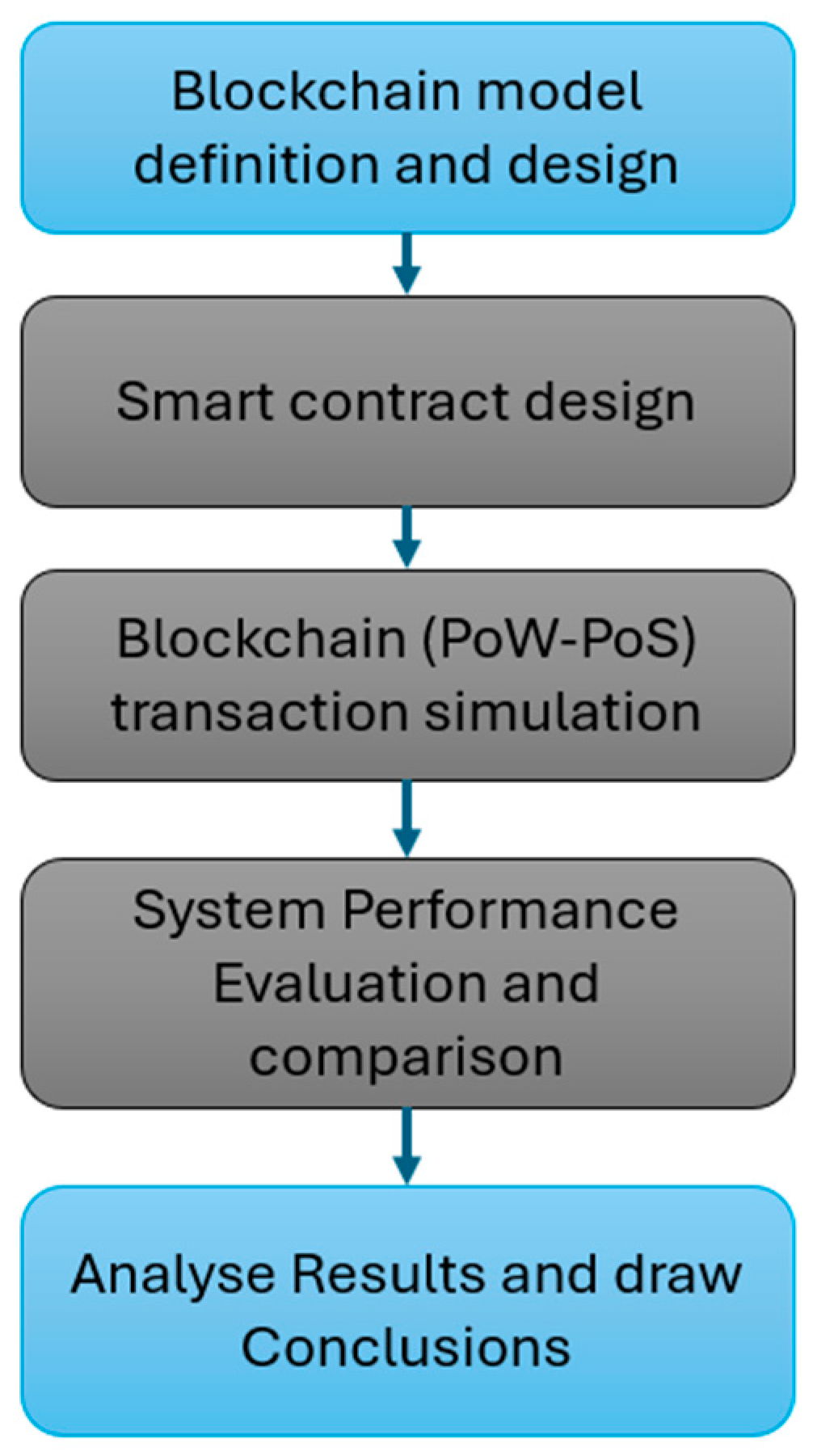
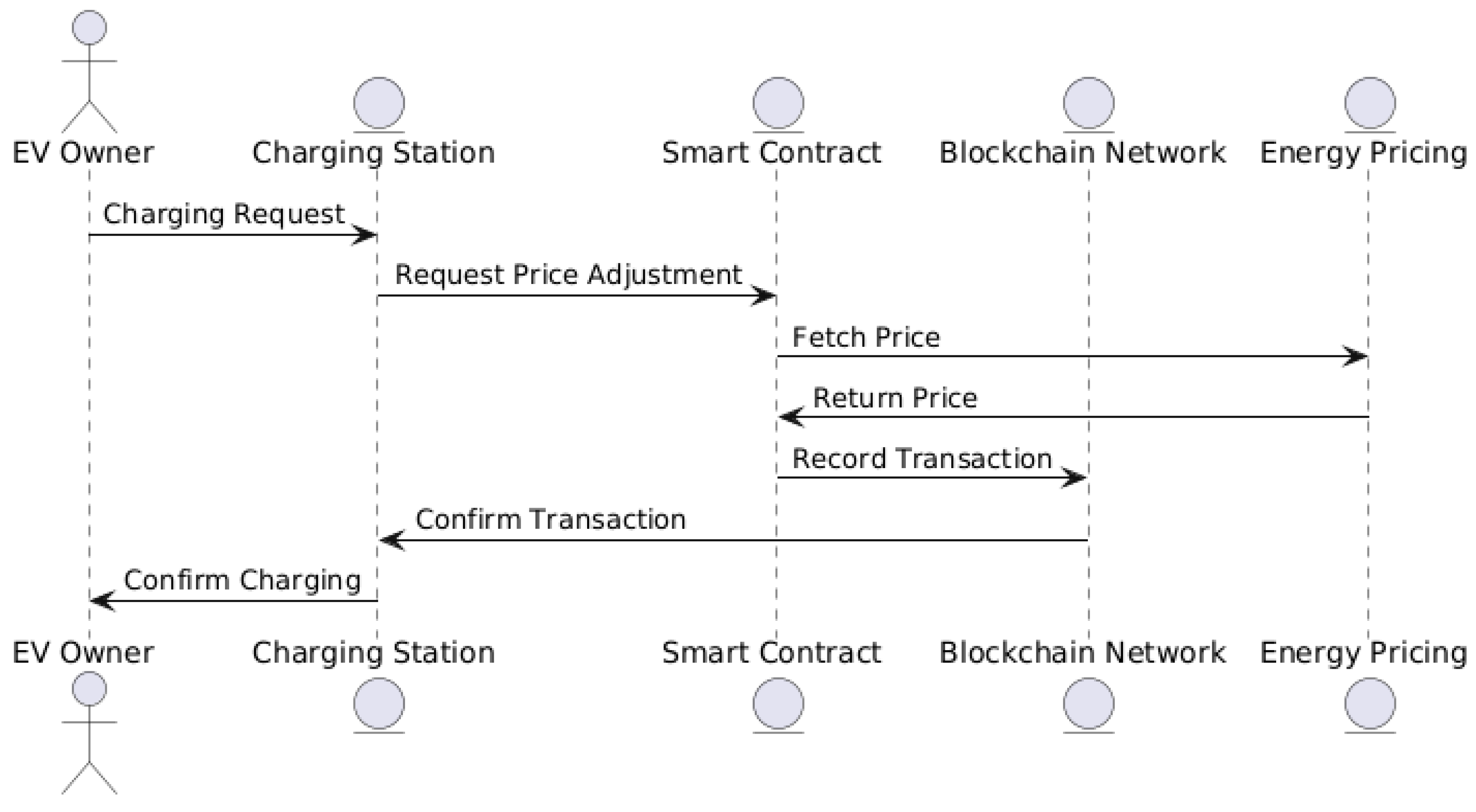
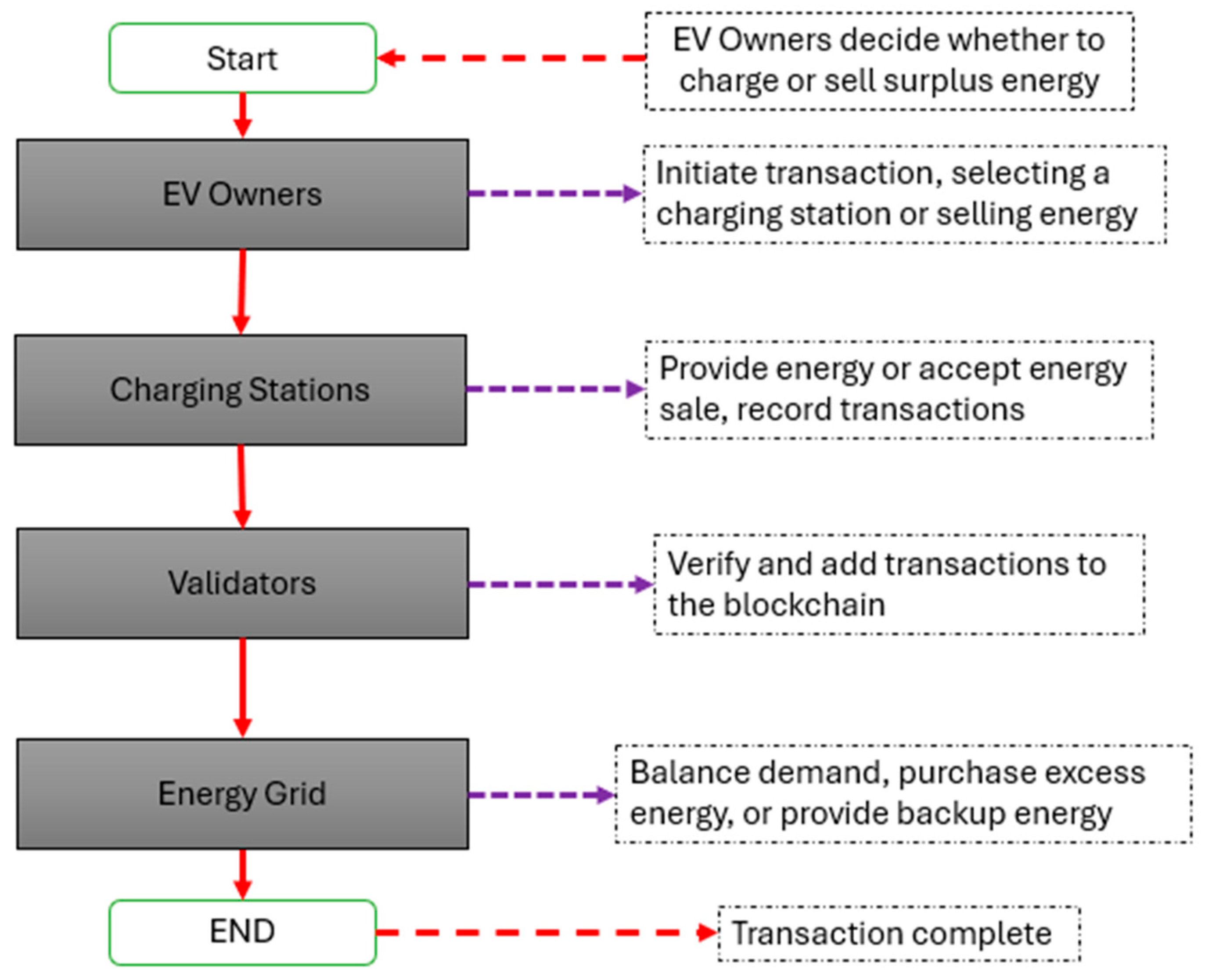
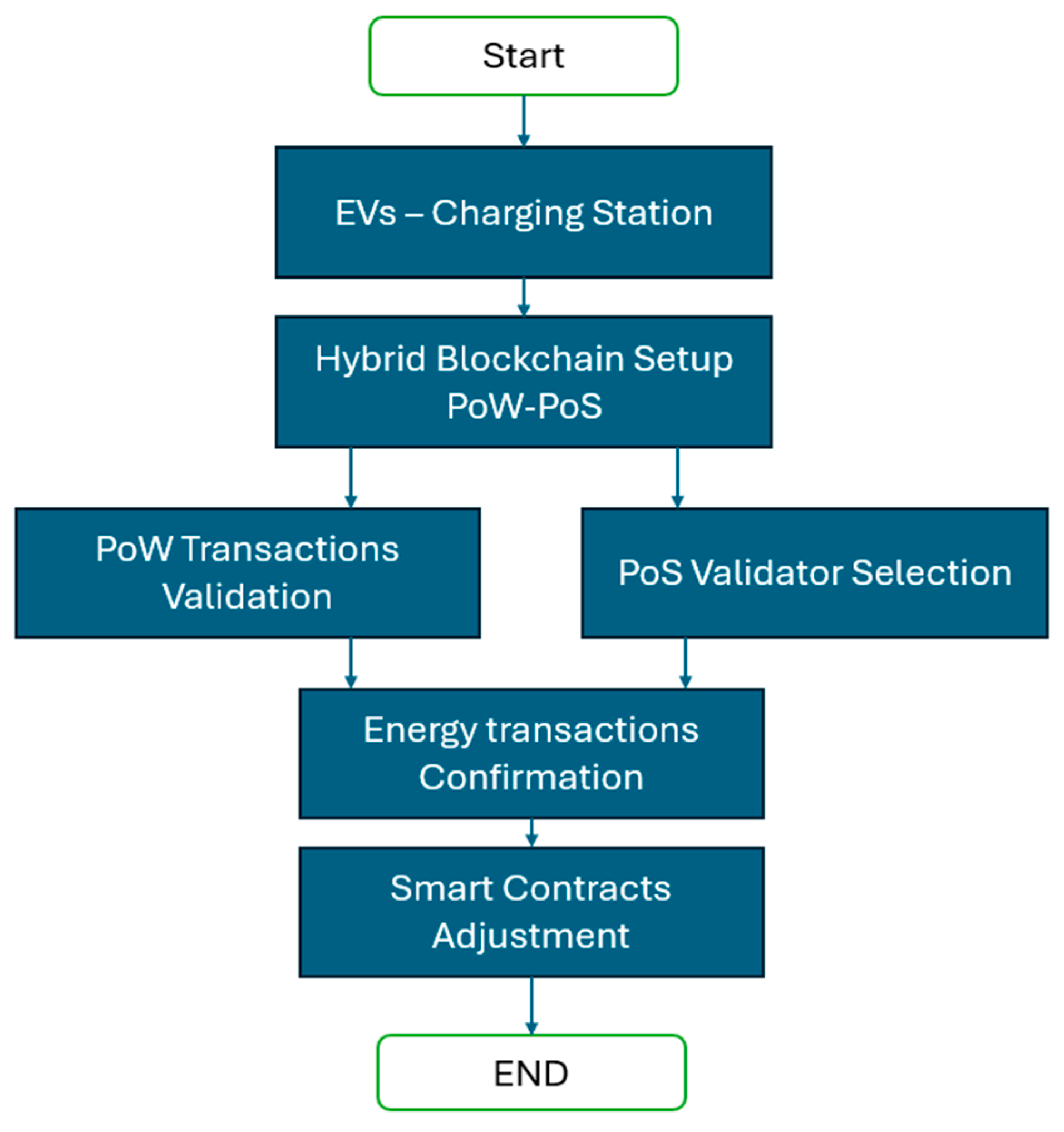
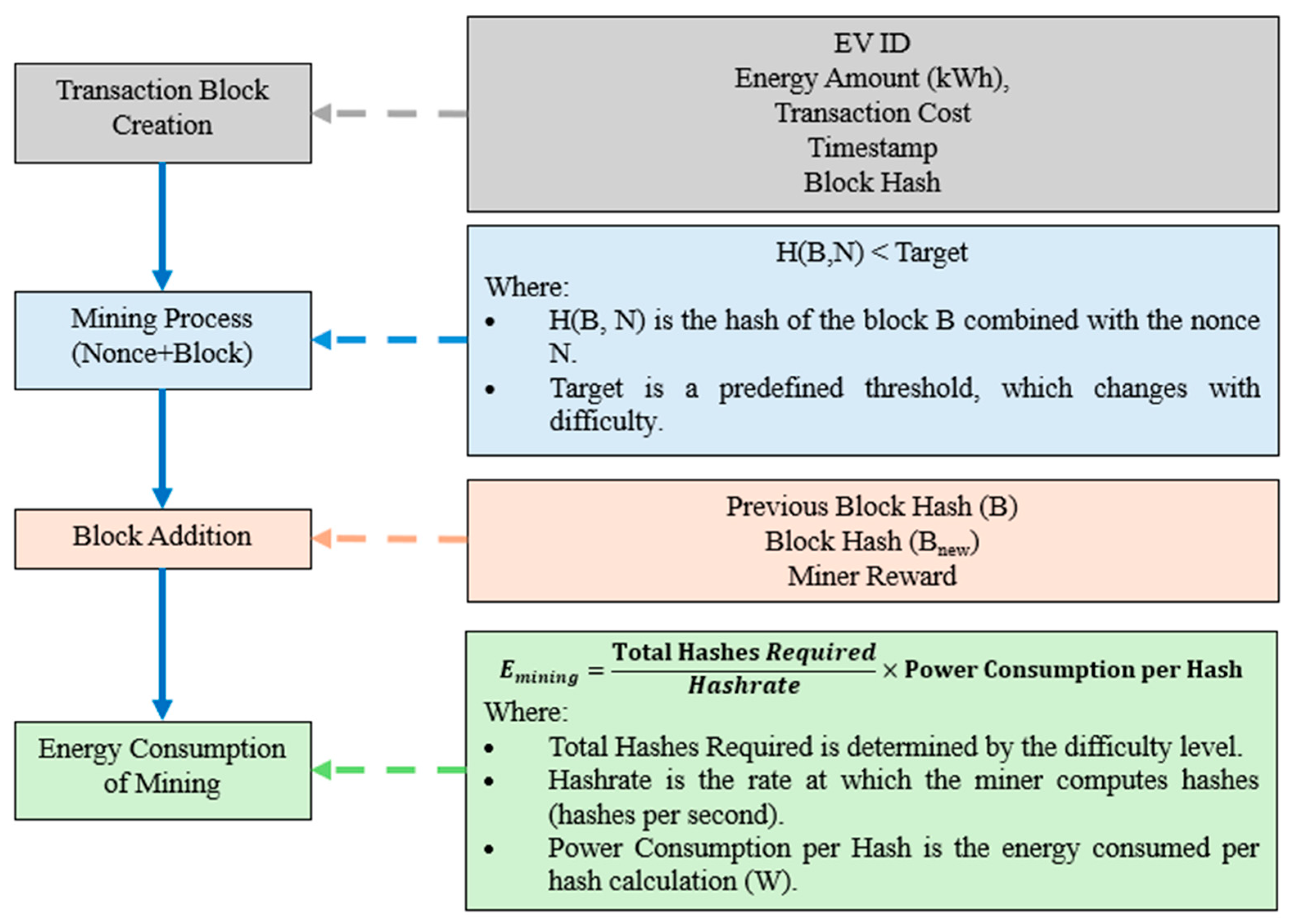



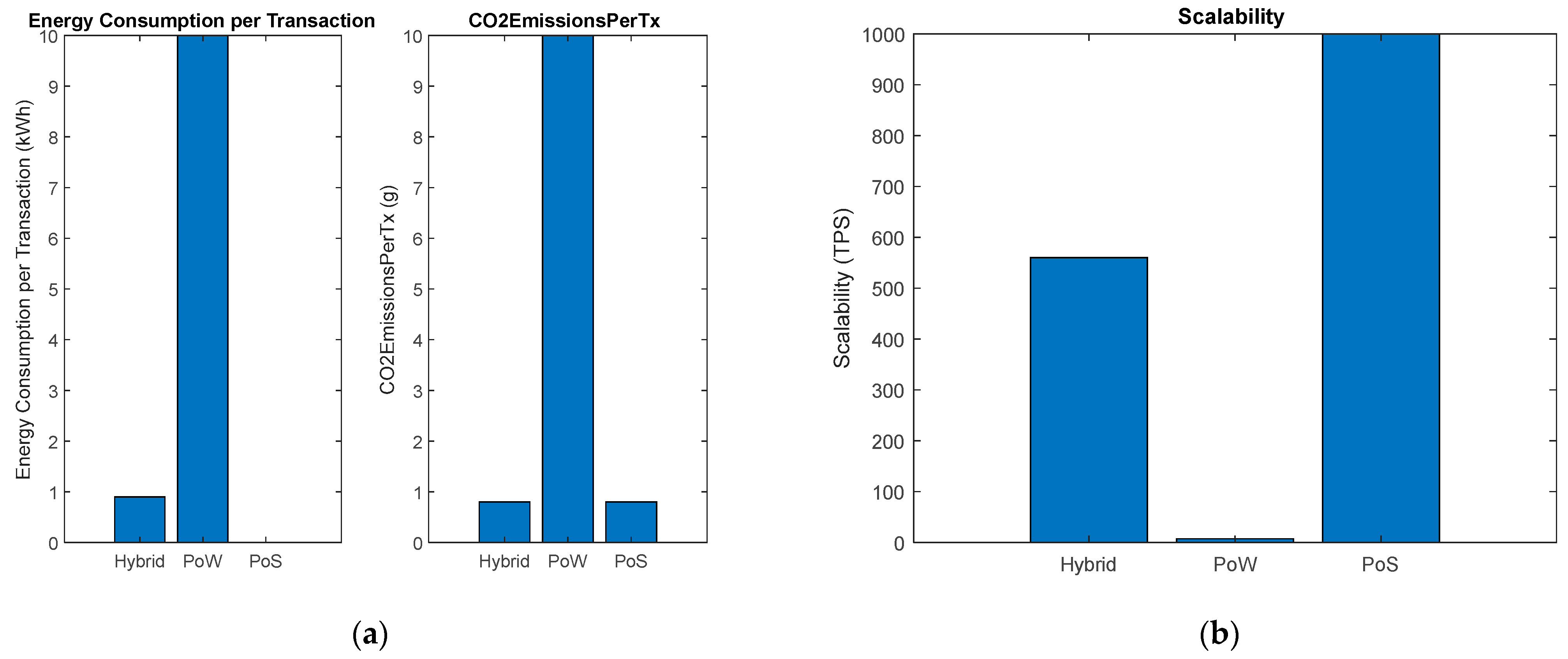
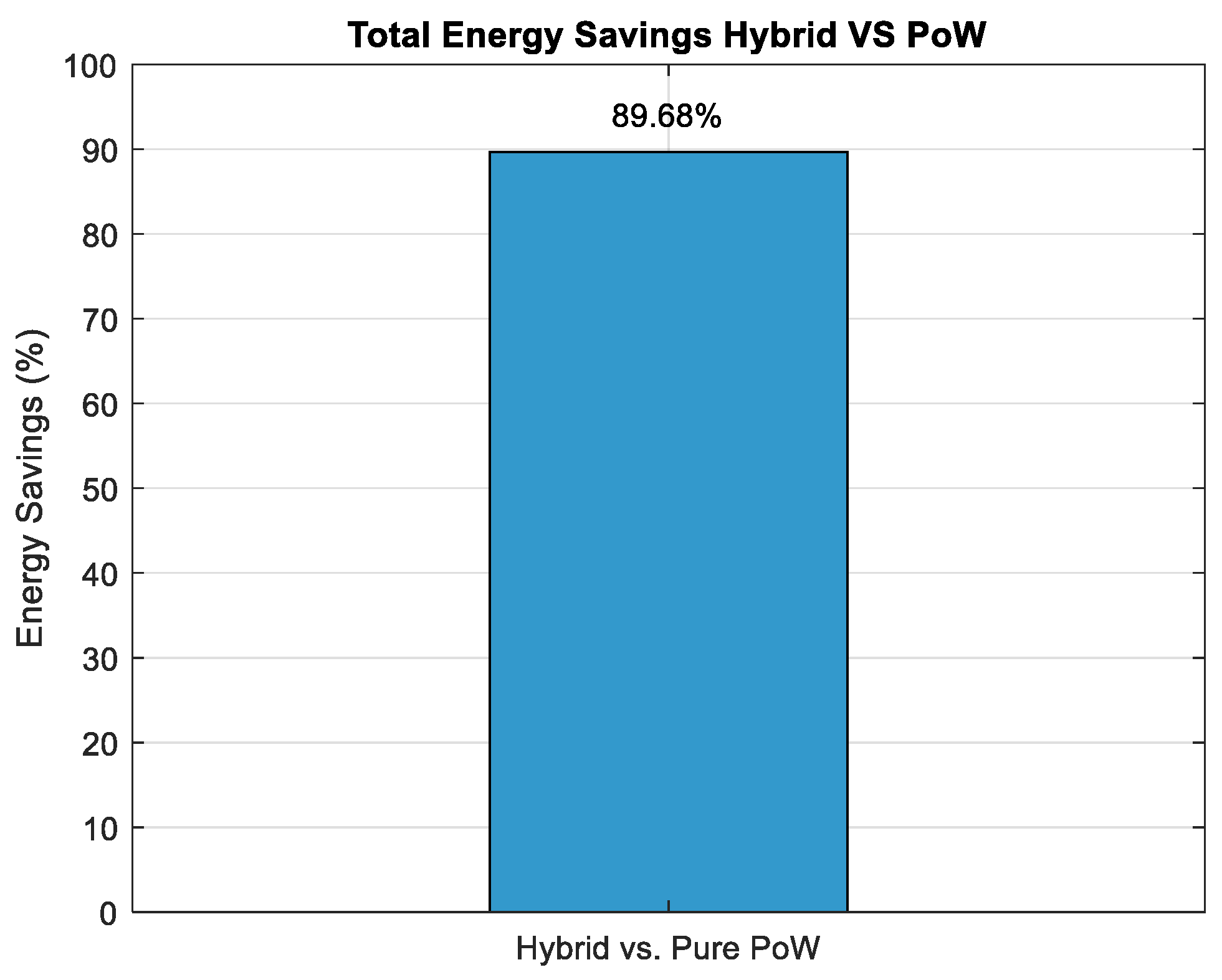
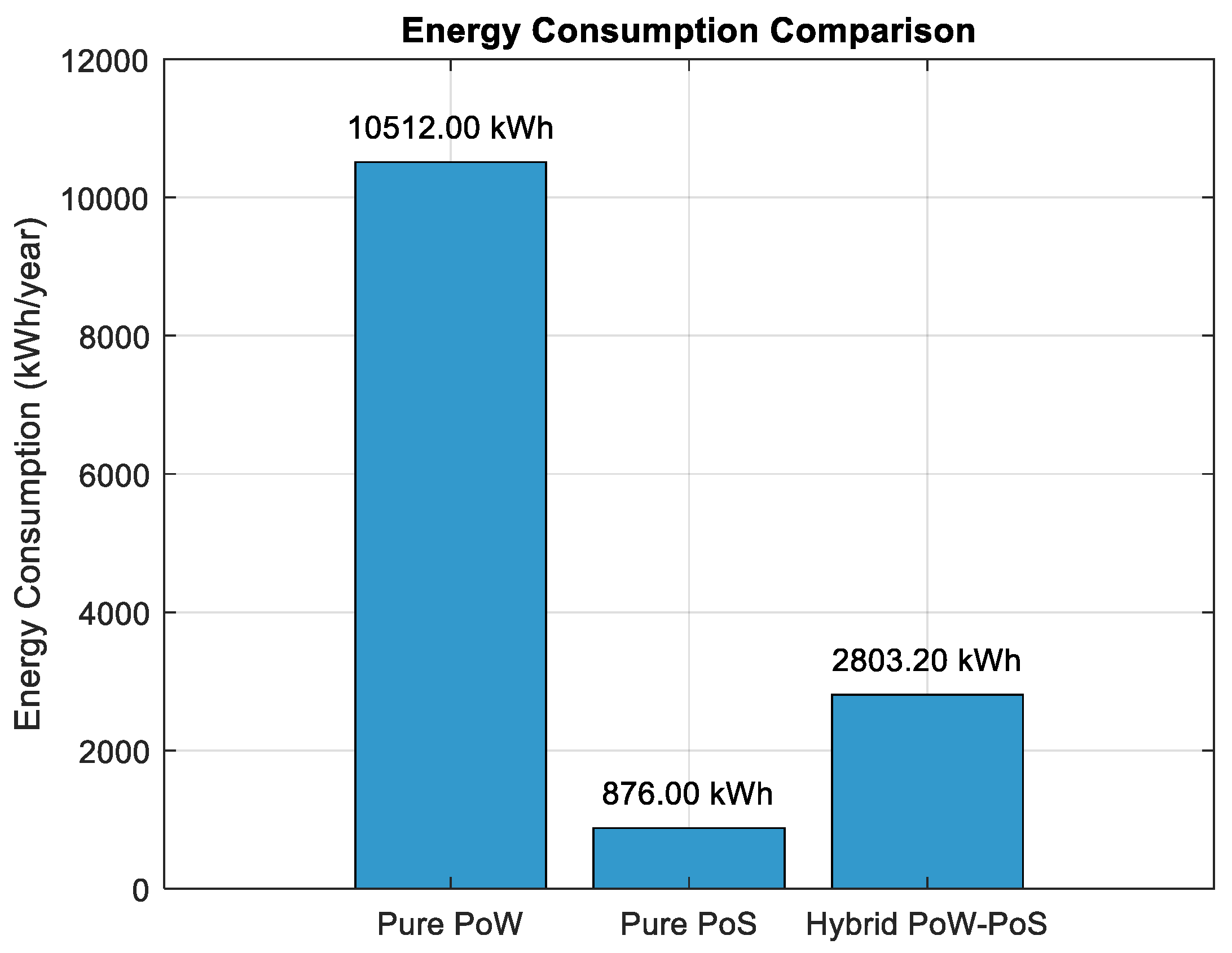
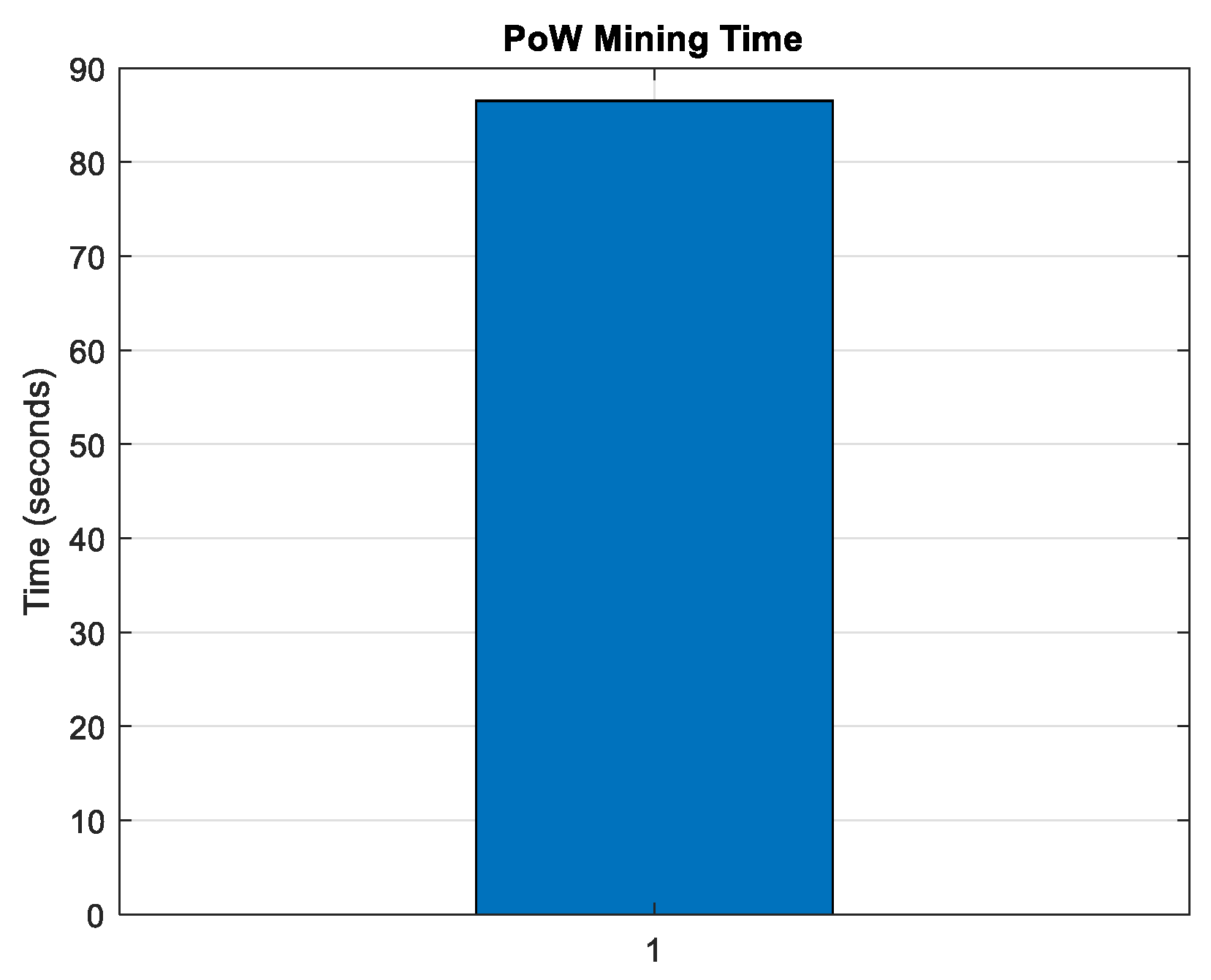
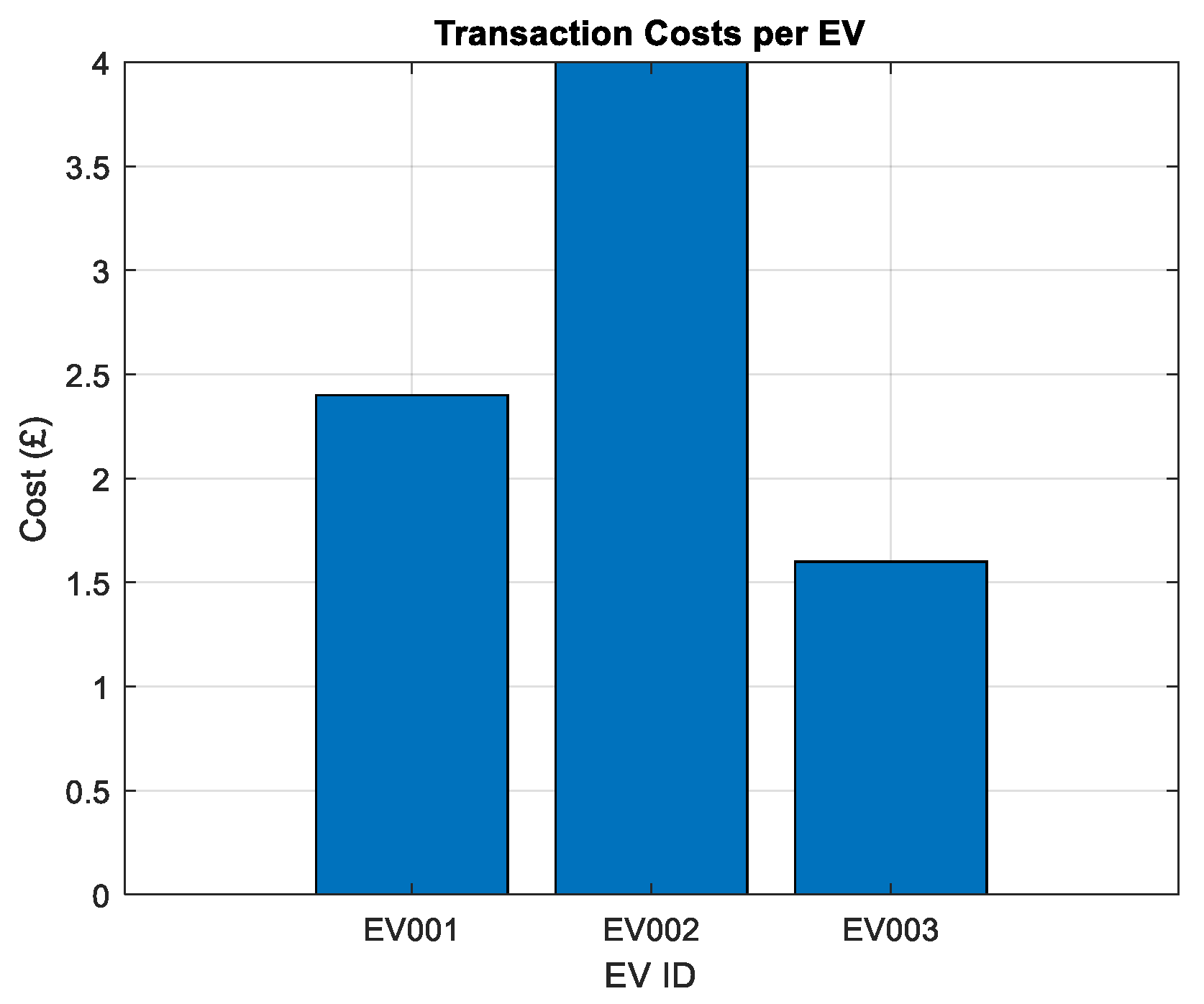


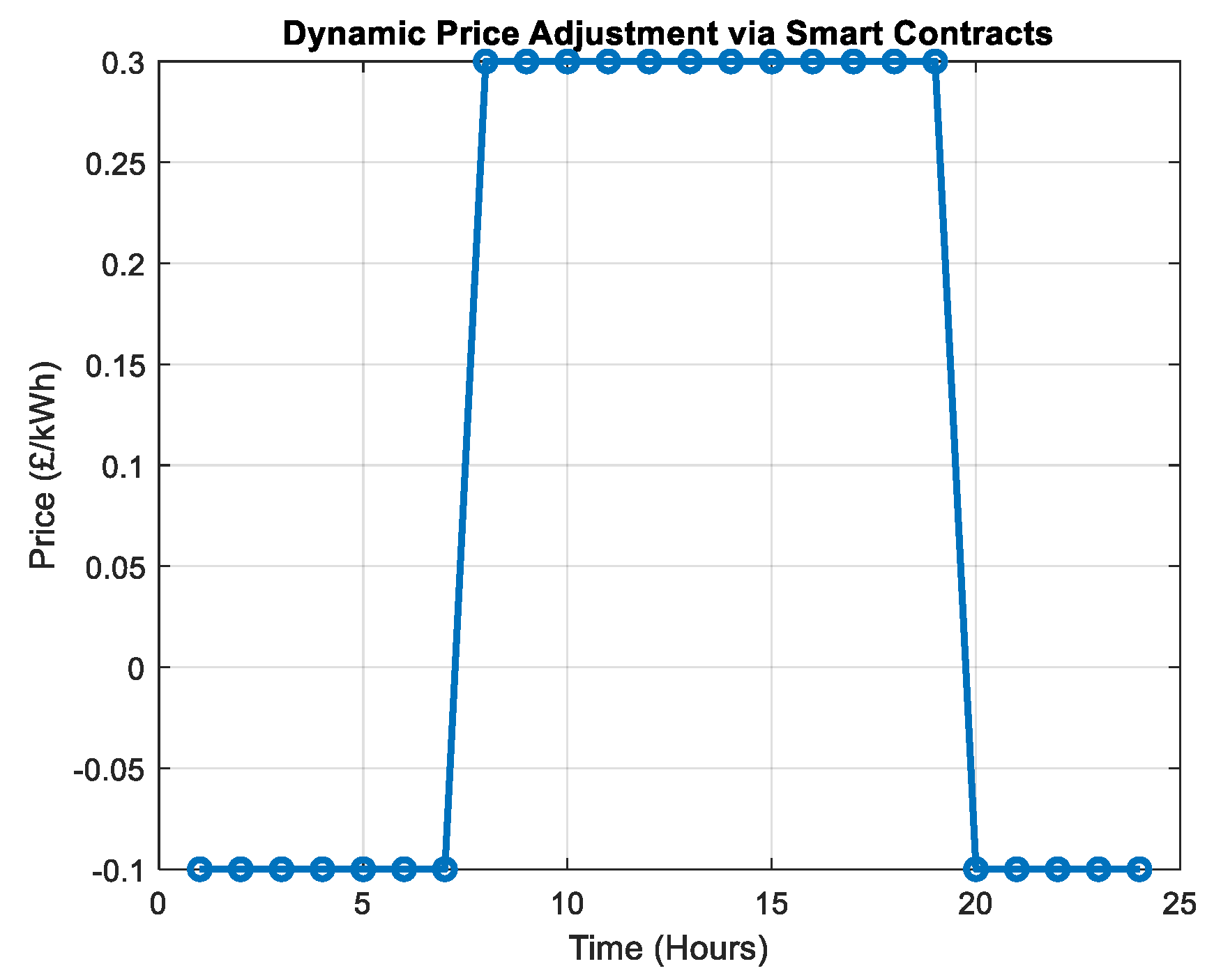
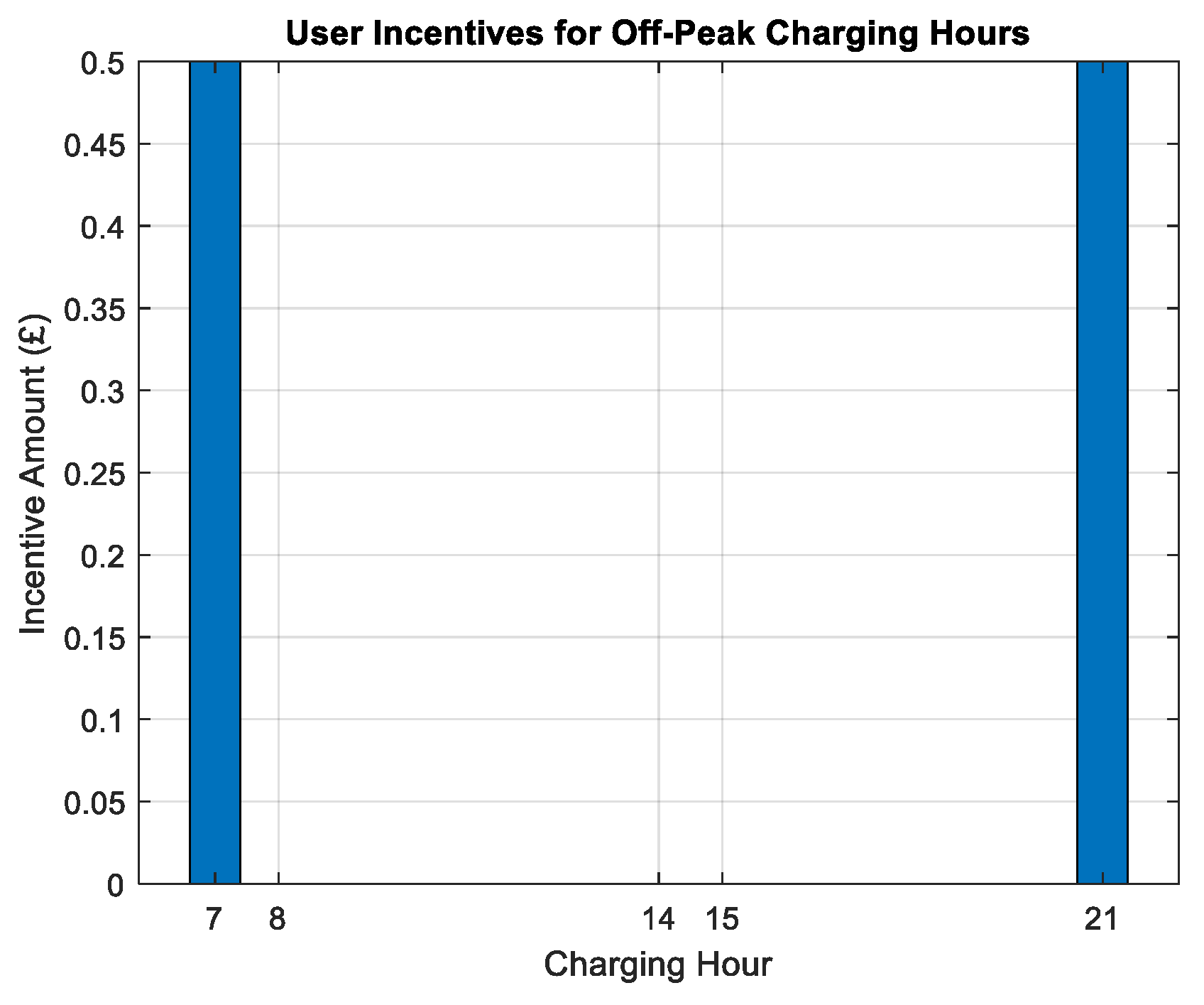
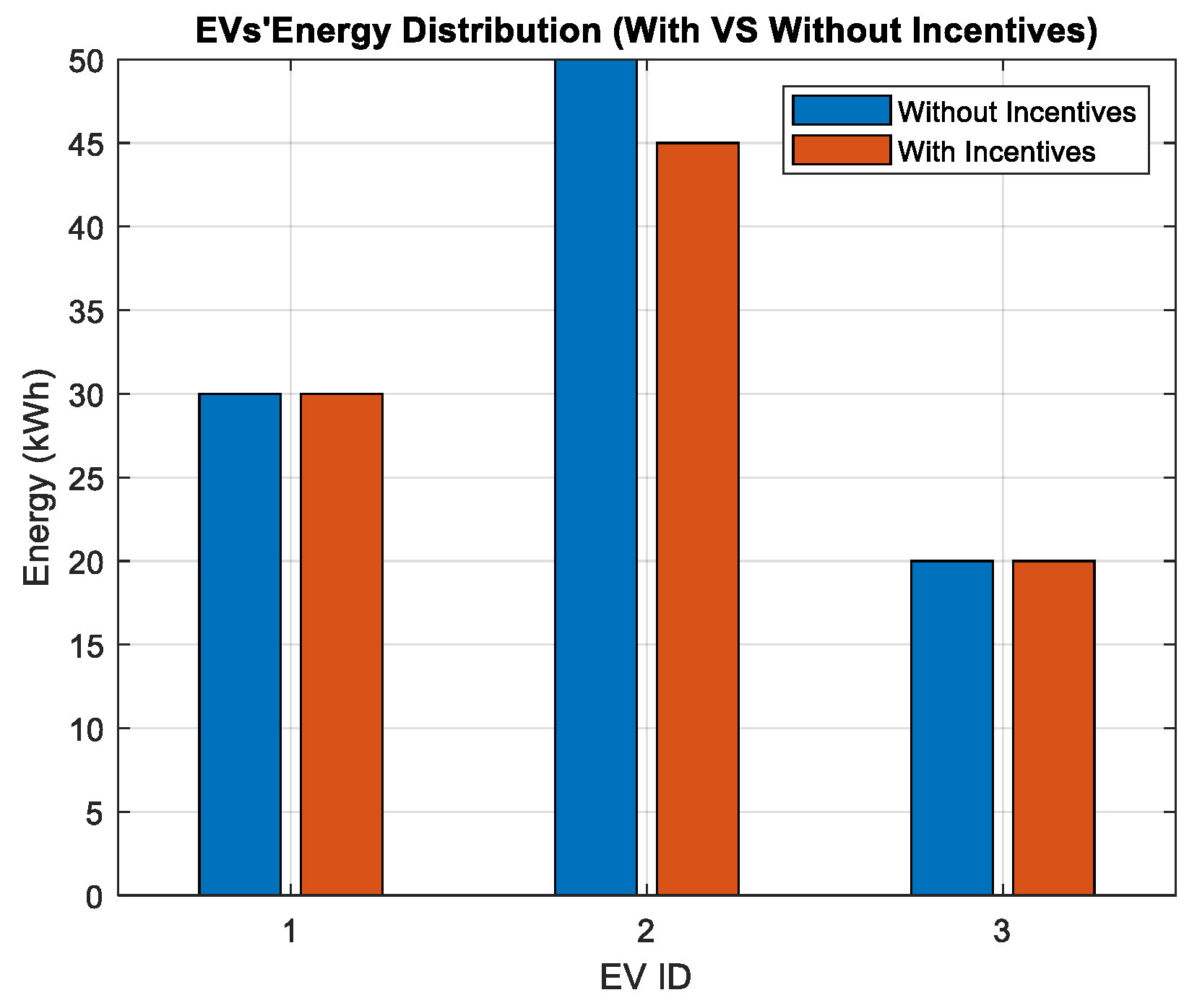
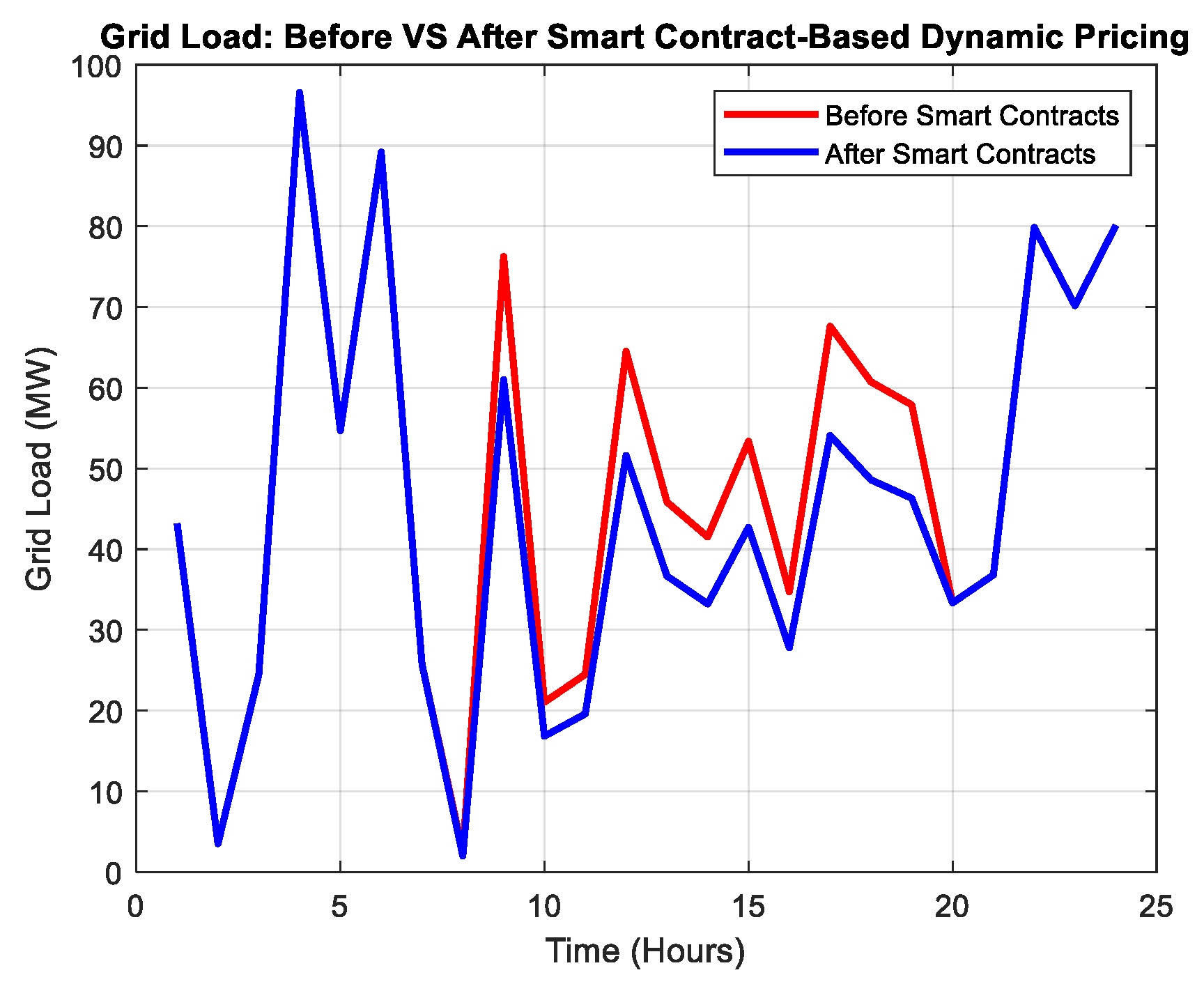
| Consensus Algorithm | Security | Scalability | Sustainability |
|---|---|---|---|
| Proof of Work (PoW) | Very High | Low | Low |
| Proof of Stake (PoS) | High | Medium | High |
| Algorithm | Energy per Transaction (KWh) |
|---|---|
| Proof of Work (PoW) | 707.6 |
| Proof of Stake (PoS) | 0.002 |
| Period | Incentive (GBP) | Charging Load (kWh) | Peak Grid Load (MW) | |
|---|---|---|---|---|
| Before Smart Contract | Peak | 0 | 10 | 77 |
| Off Peak | 0 | 8 | 97 | |
| After Smart Contract | Peak | 0 | 9 | 60 |
| Off Peak | 0.5 | 7 | 97 |
Disclaimer/Publisher’s Note: The statements, opinions and data contained in all publications are solely those of the individual author(s) and contributor(s) and not of MDPI and/or the editor(s). MDPI and/or the editor(s) disclaim responsibility for any injury to people or property resulting from any ideas, methods, instructions or products referred to in the content. |
© 2025 by the author. Licensee MDPI, Basel, Switzerland. This article is an open access article distributed under the terms and conditions of the Creative Commons Attribution (CC BY) license (https://creativecommons.org/licenses/by/4.0/).
Share and Cite
Amamra, S.-A. A Hybrid Blockchain Solution for Electric Vehicle Energy Trading: Balancing Proof of Work and Proof of Stake. Energies 2025, 18, 1840. https://doi.org/10.3390/en18071840
Amamra S-A. A Hybrid Blockchain Solution for Electric Vehicle Energy Trading: Balancing Proof of Work and Proof of Stake. Energies. 2025; 18(7):1840. https://doi.org/10.3390/en18071840
Chicago/Turabian StyleAmamra, Sid-Ali. 2025. "A Hybrid Blockchain Solution for Electric Vehicle Energy Trading: Balancing Proof of Work and Proof of Stake" Energies 18, no. 7: 1840. https://doi.org/10.3390/en18071840
APA StyleAmamra, S.-A. (2025). A Hybrid Blockchain Solution for Electric Vehicle Energy Trading: Balancing Proof of Work and Proof of Stake. Energies, 18(7), 1840. https://doi.org/10.3390/en18071840






